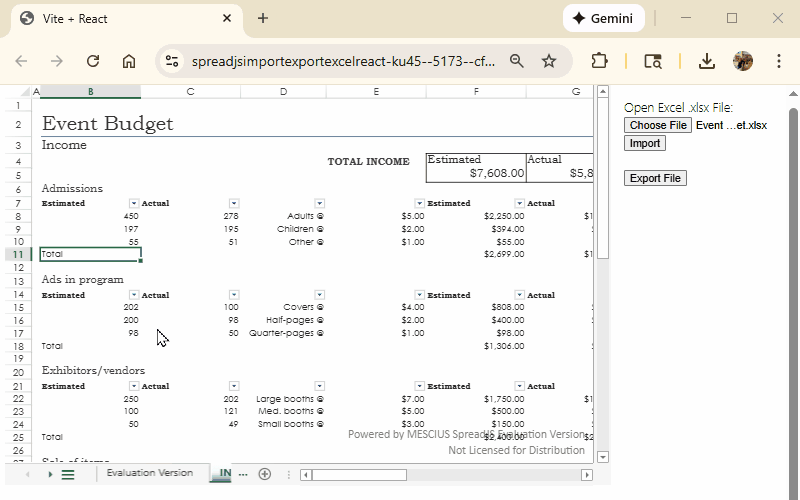How to Import and Export Excel XLSX Using React
This tutorial shows how to import and export Excel XLSX files in a React application using SpreadJS, a React spreadsheet component. You’ll learn how to set up a React project, add a spreadsheet component, and enable Excel import/export.
Try Out an Import and Export Sample
Set Up the React Spreadsheet Project
To start, we have a simple React application using Vite. We will mainly be working with the App.jsx file.
Install the required npm packages:
npm install @mescius/spread-sheets
npm install @mescius/spread-sheets-io
npm install @mescius/spread-sheets-react
npm install file-saver @mescius/spread-sheets – base SpreadJS library
@mescius/spread-sheets-io – Excel import/export
@mescius/spread-sheets-react – React spreadsheet components
file-saver – lets users save files locally
Import the JavaScript (and CSS) modules into our src/App.jsx file:
import { SpreadSheets, Worksheet } from '@mescius/spread-sheets-react';
import * as GC from '@mescius/spread-sheets';
import '@mescius/spread-sheets-io';
import { saveAs } from 'file-saver';
import '@mescius/spread-sheets/styles/gc.spread.sheets.excel2013white.css';In the JSX markup, add the SpreadJS workbook component:
<SpreadSheets hostStyle={hostStyle} workbookInitialized={(spread) => initSpread(spread)}>
</SpreadSheets>In App function, declare the needed state variables and the initSpread handler to populate the spreadstate variable when the SpreadJS instance is initialized.
const [spread, setSpread] = useState(null);
const [hostStyle, setHostStyle] = useState({
width: '100%',
height: '500px',
});
const [selectedFile, setSelectedFile] = useState(null);
const initSpread = function (spreadObj) {
setSpread(spreadObj);
};With the steps so far, the React app renders a basic spreadsheet.

Add Excel Import Code to a React App
Add an input element and a button to allow users to select their Excel (XLSX) file. Set accept=".xlsx" so only Excel (.xlsx) files can be selected.
<input type="file" id="selectedFile" accept=".xlsx" onChange={handleFileChange} />
<button className="settingButton" id="btnImport" onClick={handleOpenExcel}>Import</button>The input has a change event handler that updates the file variable to the most recently selected file. The file change handler is quite simple:
const handleFileChange = function (e) {
setSelectedFile(e.target.files[0]);
};The button has a click handler that triggers the file import.
To make that work, add a function to import a file using spreads import method. These handlers are also added to theApp function in src/App.jsx.
const handleOpenExcel = function () {
const file = selectedFile;
if (!file) {
return;
}
spread.import(file);
};An Excel (.xlsx) file can now be imported and viewed in the React spreadsheet component like so:

Add Excel Export Code to a React App
Add a button to export the file by invoking the Spreadsheet’s export method in its click event handler:
const handleSaveExcel = function () {
var fileName = 'Excel_Export.xlsx';
spread.export(
function (blob) {
// save blob to a file
saveAs(blob, fileName);
},
function (e) {
console.log(e);
},
{
fileType: GC.Spread.Sheets.FileType.excel,
}
);
};The exported filename is hardcoded to be “Excel_Export.xlsx” but could be made into an input element for users to choose themselves.
Add an Export File button that calls the handleSaveExcel function on click.
<button id="btnExport" onClick={handleSaveExcel}>Export File</button>Users can now edit the spreadsheet within the React app and export it with the Export File button. The exported file opens in Excel with all changes preserved.

This is just one example of how you can use SpreadJS React spreadsheets to add data to your Excel files and then export them back to Excel with simple JavaScript code.
Include Extra Features
If you want to import and export Excel files with Charts, Shapes and PivotTables, make sure to include those optional add-on modules for SpreadJS (@mescius/spread-sheets-charts, @mescius/spread-sheets-shapes and @mescius/spread-sheets-pivot-addon).
Import and Export Excel FAQs
Do I need to have Excel installed for this import or export in React to work?
No! SpreadJS is a stand-alone React component that can import and export Excel files without depending on Excel at all.
Can my end users changes be included in the export?
Yes! SpreadJS allows users to modify spreadsheets in an Excel-like experience. Those changes will be included when the spreadsheet is exported.
What types of files can be imported or exported?
SpreadJS supports import and export of .xlsx, .xlsm, .xltm file types. It can even import .csv files and has a custom SpreadJS (.sjs)file format for optimized performance and app development.
Do you support Excel files with macros?
The macros will not run, but Excel files with macros can be imported and exported without losing the macros. The macros simply will be ignored when the spreadsheet runs in SpreadJS. Note: most macro use cases can be replicated in custom JavaScript code using SpreadJS


